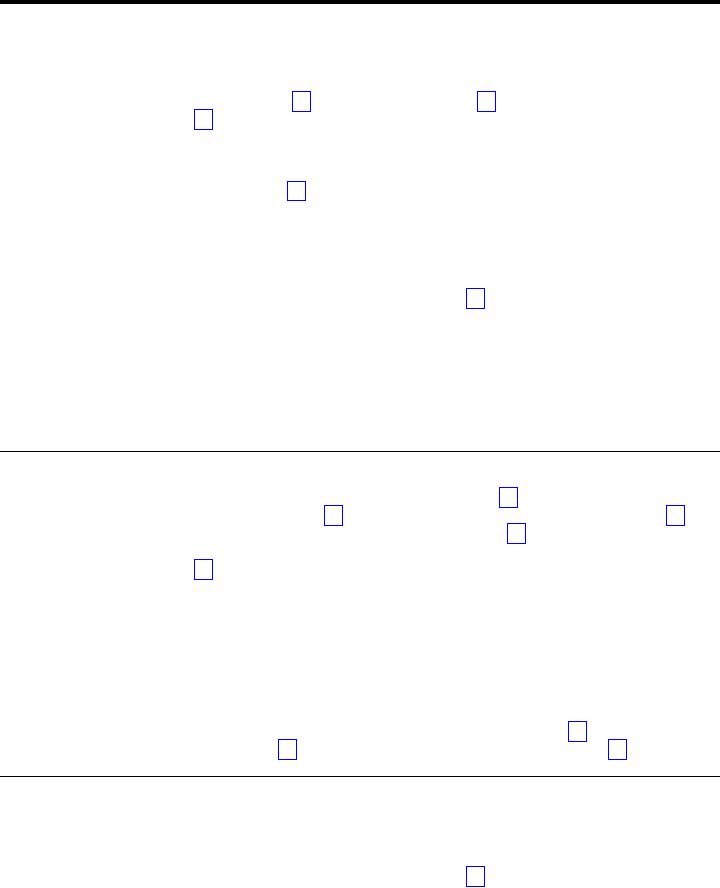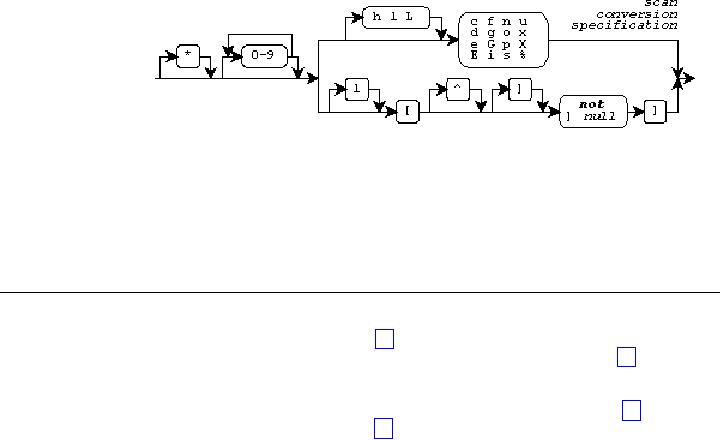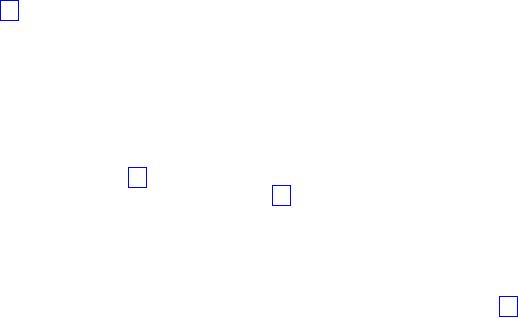 |

Chapter
7. Formatted Input
(page 26)
Several
library functions help you
convert data values from
text sequences that
are
generally
readable by people to encoded
internal representations. You
provide a
format
string (page 31)
as the value of the format
argument
to each of these
functions,
hence the term formatted
input. The
functions fall into two
categories:
The
byte
scan functions (declared
in <stdio.h>) convert sequences of
type char
to
internal
representations, and help you scan
such sequences that you
read: fscanf,
scanf, and sscanf. For
these functions, a format
string is a multibyte string
that
begins
and ends in the initial
shift state (page 12).
The
wide
scan functions (declared
in <wchar.h> and hence added
with
Amendment
1)
convert sequences of type
wchar_t, to internal representations,
and
help
you scan such sequences that
you read: fwscanf, wscanf
and
swscanf.
For
these
functions, a format string is a
wide-character string. In the
descriptions that
follow,
a wide character wc
from a
format string or a stream is
compared to a
specific
(byte) character c
as if by
evaluating the expression wctob(wc)
== c.
Scan
Formats
A
format string has the
same general syntax
(page 31)
for
the scan functions as
for
interspersed
with literal text and white
space (page 31).
For the scan
functions,
however,
a conversion specification is one of
the scan conversion
specifications
(page
25)
described below.
A
scan function scans the
format string once from
beginning to end to
determine
what
conversions to perform. Every
scan function accepts a
varying number of
arguments,
either directly or under
control of an argument of type
va_list. Some
scan
conversion specifications in the
format string use the
next argument in the
list.
A scan function uses each
successive argument no more
than once. Trailing
arguments
can be left unused.
In
the description that
follows, the integer
conversions (page 32)
and floating-point
Scan
Functions
For
the scan functions, literal
text in a format string must
match the next
characters
to
scan in the input text.
White space in a format
string must match the
longest
possible
sequence of the next zero or
more white-space characters in
the input.
Except
for the scan conversion
specifier (page 26)
%n (which consumes no
input),
each
scan
conversion specification determines
a pattern that one or more
of the
next
characters in the input must
match. And except for the
scan conversion
specifiers
c, n, and [, every match begins by
skipping any white space
characters in
the
input.
A
scan function returns
when:
25

v
it
reaches the terminating null in
the format string
v
it
cannot obtain additional
input characters to scan
(input
failure)
v
a
conversion fails (matching
failure)
A
scan function returns EOF if
an input failure occurs
before any
conversion.
Otherwise
it returns the number of
converted values stored. If
one or more
characters
form a valid prefix but the
conversion fails, the valid
prefix is consumed
before
the scan function returns.
Thus:
scanf("%i",
&i)
consumes
0X from field 0XZ
scanf("%f",
&f)
consumes
3.2E from field 3.2EZ
A
scan conversion specification
typically converts the
matched input characters
to
a
corresponding encoded value.
The next argument value
must be the address
of
an
object. The conversion
converts the encoded
representation (as necessary)
and
stores
its value in the object. A
scan conversion specification
has the format
shown
in
the diagram.
Following
the percent character
(%) in the
format string, you can write
an asterisk
(*) to
indicate that the conversion
should not store the
converted value in an
object.
Following
any *, you
can write a nonzero
field
width that
specifies the maximum
number
of input characters to match for
the conversion (not counting
any white
space
that the pattern can
first skip).
Scan
Conversion Specifiers
Following
any field width (page 26),
you must write a one-character
scan
conversion
specifier, either
a one-character code or a scan
set (page 28),
possibly
preceded
by a one-character qualifier. Each
combination determines the
type
required
of the next argument (if
any) and how the scan
functions interpret
the
text
sequence and converts it to an encoded
value. The integer (page 32)
and
floating-point
conversions (page 32)
also determine what base to
assume for the
text
representation. (The base is
the base
argument
to the functions strtol
and
strtoul.) The
following table lists all
defined combinations and their
properties.
Conversion
Argument
Conversion
Specifier
Type
Function
Base
%c
char
x[]
%lc
wchar_t
x[]
%d
int
*x
strtol
10
%hd
short
*x
strtol
10
%ld
long
*x
strtol
10
%e
float
*x
strtod
10
%le
double
*x
strtod
10
%Le
long
double *x
strtod
10
%E
float
*x
strtod
10
%lE
double
*x
strtod
10
%LE
long
double *x
strtod
10
%f
float
*x
strtod
10
26
Standard
C++ Library

%lf
double
*x
strtod
10
%Lf
long
double *x
strtod
10
%g
float
*x
strtod
10
%lg
double
*x
strtod
10
%Lg
long
double *x
strtod
10
%G
float
*x
strtod
10
%lG
double
*x
strtod
10
%LG
long
double *x
strtod
10
%i
int
*x
strtol
0
%hi
short
*x
strtol
0
%li
long
*x
strtol
0
%n
int
*x
%hn
short
*x
%ln
long
*x
%o
unsigned
int *x
strtoul
8
%ho
unsigned
short *x
strtoul
8
%lo
unsigned
long *x
strtoul
8
%p
void
**x
%s
char
x[]
%ls
wchar_t
x[]
%u
unsigned
int *x
strtoul
10
%hu
unsigned
short *x
strtoul
10
%lu
unsigned
long *x
strtoul
10
%x
unsigned
int *x
strtoul
16
%hx
unsigned
short *x
strtoul
16
%lx
unsigned
long *x
strtoul
16
%X
unsigned
int *x
strtoul
16
%hX
unsigned
short *x
strtoul
16
%lX
unsigned
long *x
strtoul
16
%[...]
char
x[]
%l[...]
wchar_t
x[]
%%
none
The
scan conversion specifier
(or scan set (page 28))
determines any behavior
not
summarized
in this table. In the
following descriptions, examples follow
each of
the
scan conversion specifiers. In
each example, the function
sscanf
matches
the
bold
characters.
You
write %c
to
store the matched input
characters in an array object. If
you
specify
no field width w,
then
w
has
the value one. The
match does not
skip
leading
white space (page 31).
Any sequence of w
characters
matches the
conversion
pattern.
sscanf("129E-2",
"%c", &c)
stores
'1'
sscanf("129E-2",
"%2c", &c[0])
stores
'1', '2'
For
a wide stream (page 18),
conversion occurs as if by repeatedly
calling wcrtomb,
beginning
in the initial conversion
state (page 12).
swscanf(L"129E-2",
L"%c", &c)
stores
'1'
You
write %lc
to
store the matched input
characters in an array object,
with
elements
of type wchar_t. If you specify no
field width w,
then
w
has
the value
one.
The match does not
skip leading white space
(page 31).
Any sequence of w
characters
matches the conversion
pattern. For a byte stream
(page 18),
conversion
occurs
as if by repeatedly calling mbrtowc,
beginning in the initial
conversion state
(page
12).
sscanf("129E-2",
"%lc", &c)
stores
L'1'
sscanf("129E-2",
"%2lc", &c)
stores
L'1', L'2'
swscanf(L"129E-2",
L"%lc", &c)
stores
L'1'
You
write %d,
%i,
%o,
%u,
%x,
or %X
to
convert the matched input
characters as
a
signed integer and store the
result in an integer
object.
27
Chapter
7. Formatted Input

sscanf("129E-2",
"%o%d%x", &i, &j, &k) stores
10, 9, 14
You
write %e,
%E,
%f,
%g,
or %G
to
convert the matched input
characters as a
signed
fraction, with an optional exponent, and
store the result in a
floating-point
object.
sscanf("129E-2",
"%e", &f)
stores
1.29
You
write %n
to
store the number of
characters matched (up to this
point in the
format)
in an integer object. The
match does not skip
leading white space and
does
not
match any input
characters.
sscanf("129E-2",
"12%n", &i)
stores
2
You
write %p
to
convert the matched input
characters as an external
representation
of
a pointer
to void and
store the result in an
object of type pointer
to void. The
input
characters
must match the form
generated by the %p print
conversion specification
(page
32).
sscanf("129E-2",
"%p", &p)
stores,
e.g. 0x129E
You
write %s
to
store the matched input
characters in an array object,
followed by
a
terminating null character. If you do not
specify a field width w,
then
w
has
a
large
value. Any sequence of up to w non
white-space characters matches
the
conversion
pattern.
sscanf("129E-2",
"%s", &s[0])
stores
"129E-2"
For
a wide stream (page 18),
conversion occurs as if by repeatedly
calling wcrtomb
beginning
in the initial conversion
state (page 12).
swscanf(L"129E-2",
L"%s", &s[0])
stores
"129E-2"
You
write %ls
to
store the matched input
characters in an array object,
with
elements
of type wchar_t, followed by a
terminating null wide character. If you
do
not
specify a field width w,
then
w
has
a large value. Any sequence of up to
w
non
white-space
characters matches the
conversion pattern. For a
byte stream (page 18),
conversion
occurs as if by repeatedly calling
mbrtowc,
beginning in the
initial
conversion
state.
sscanf("129E-2",
"%ls", &s[0])
stores
L"129E-2"
swscanf(L"129E-2",
L"%ls", &s[0])
stores
L"129E-2"
You
write %[
to
store the matched input
characters in an array object,
followed by
a
terminating null character. If you do not
specify a field width w,
then
w
has
a
large
value. The match does
not skip leading white
space. A sequence of up to w
characters
matches the conversion
pattern in the scan
set that
follows. To complete
the
scan set, you follow the left
bracket ([) in the
conversion specification with a
sequence
of zero or more match
characters,
terminated by a right bracket
(]).
If
you do not write a caret
(^)
immediately after the [, then
each input character
must
match one
of
the match characters.
Otherwise, each input
character must not
match
any
of
the match characters, which
begin with the character
following the ^.
If
you write a ]
immediately
after the [
or
[^, then
the ]
is
the first match
character,
not the terminating ]. If you
write a minus (-) as
other than the first
or
last
match character, an implementation
can give it special meaning. It
usually
indicates
a range of characters, in conjunction
with the characters
immediately
preceding
or following, as in 0-9
for
all the digits.) You
cannot specify a null
match
character.
sscanf("129E-2",
"[54321]", &s[0])
stores
"12"
28
Standard
C++ Library

For
a wide stream (page 18),
conversion occurs as if by repeatedly
calling wcrtomb,
beginning
in the initial conversion
state.
swscanf(L"129E-2",
L"[54321]", &s[0])
stores
"12"
You
write %l[
to
store the matched input
characters in an array object,
with
elements
of type wchar_t, followed by a
terminating null wide character. If you
do
not
specify a field width w,
then
w
has
a large value. The match
does not skip
leading
white space. A sequence of up to
w
characters
matches the
conversion
pattern
in the scan set (page 28)
that follows.
For
a byte stream (page 18),
conversion occurs as if by repeatedly
calling mbrtowc,
beginning
in the initial conversion
state.
sscanf("129E-2",
"l[54321]", &s[0])
stores
L"12"
swscanf(L"129E-2",
L"l[54321]", &s[0]) stores
L"12"
You
write %%
to
match the percent character
(%). The
function does not store
a
value.
sscanf("%
0XA", "%%
%i")
stores
10
29
Chapter
7. Formatted Input
30
Standard
C++ Library
Table of Contents:
- C++ Library
- C++ Library Overview:Using C++ Library Headers, Iostreams Conventions
- Characters:Escape Sequences, Multibyte Characters, Wide-Character Encoding
- Expressions
- Files and Streams:Text and Binary Streams, Controlling Streams, Stream States
- Indefinite Integrals of Logarithmic Functions:Combinations of Logarithms and Polynomials, The Logarithm
- Formatted Input:Scan Formats, Scan Functions, Scan Conversion Specifiers
- Formatted Output:Print Formats, Print Functions, Print Conversion Specifiers
- STL Conventions:Iterator Conventions, Algorithm Conventions
- Containers:Cont::const_reference, difference_type, reverse_iterator
- Preprocessing
- Standard C++ Library Header Files:bitset, conj, cos, showpoint, streampos
- Standard Template Library C++:adjacent_find, copy_backward, lexicographical_compare
- Appendix. Type Traits:Helper Class, Primary Type Categories, Binary Type Traits
- Notices:References, Bug Reports